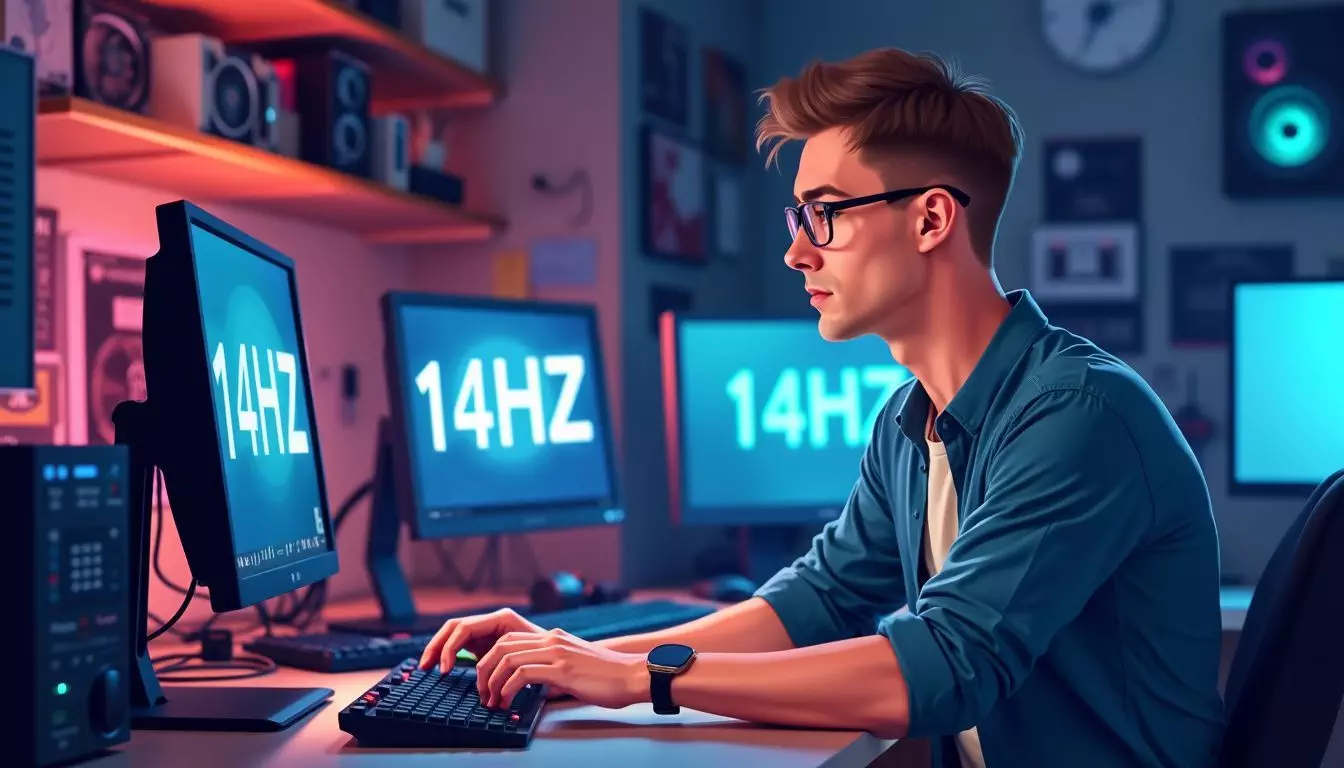Is 144Hz Refresh Rate Good? Exploring 144Hz vs. 240Hz Monitors.
For gamers and tech enthusiasts, the refresh rate is crucial. The question “is 144Hz refresh rate good?” often comes up. A higher refresh rate delivers smoother visuals, which means better gameplay and user experience. 2
Alex Herrick has a strong background in web design and research, making him well-equipped to explore this topic. His expertise ensures readers get detailed insights into 144Hz and 240Hz monitors. 3 So, let’s dive deeper….
Key Takeaways
- A 144Hz monitor offers smooth visuals, making it great for most gamers. It costs between $200 to $400.
- A 240Hz monitor provides even smoother gameplay, but it’s pricier ($400-$800+) and needs a high-end GPU like the RTX 3060.
- Lower input lag means better game response times. The jump from 60Hz to 144Hz is noticeable; the jump to 240Hz is smaller.
- Professional gamers often choose 240Hz monitors for an edge in fast-paced games like Fortnite and PUBG.
- Monitors with higher refresh rates need features like G-Sync or FreeSync to reduce screen tearing and improve performance.
Understanding Refresh Rates: 144Hz vs 240Hz

A monitor’s refresh rate tells how many times it updates the image on screen per second. A higher refresh rate can make gaming smoother and faster… but is 144Hz good enough, or do you need a 240Hz?
Benefits of 144Hz Monitors144Hz monitors provide a smooth gaming experience, showing 144 unique frames per second with only 6.94 ms between each frame. 2 This clarity helps entry-level pro gamers see motion better. 1
They’re also more affordable than 240Hz monitors and work well with many games. 1 You get enhanced visibility without needing top-tier graphics cards or the latest tech… making them great for most gaming setups!
Benefits of 240Hz Monitors
A 240Hz monitor is four times faster than a 60Hz monitor. 4 This means smoother movements and less motion blur. Players see the game more clearly, which helps in fast-paced games.
Lower input lag improves response time. With a mid-range GPU like the RTX 3060, gamers can achieve this refresh rate at 1080p. 3 A study by NVIDIA shows players have a 53% higher kill/death ratio with a 240Hz display.
The increased responsiveness of a 240Hz monitor feels incredible for any gamer. – Alex Herrick
Visual and Performance Comparison
144Hz monitors reduce motion blur more effectively than 60Hz ones, making fast-moving scenes look smoother. But, 240Hz displays push the limit even further, giving gamers a noticeable edge in competitive play.
Motion Blur Reduction
Motion blur can be annoying, especially for gamers. Higher refresh rates like 144Hz and 240Hz cut down on this issue. A 240Hz monitor displays images every 4.17 ms, which is faster than a 144Hz monitor at about 6.94 ms.
This speed helps reduce motion blur significantly. 2
Faster response times also play a role here—quick response means less ghosting and crisper visuals during fast actions in games or videos. Reducing input lag further enhances these benefits, making movements seem more natural and smooth. 5
– Competitive Gaming EdgeCompetitive Gaming Edge
Professional gamers use high-refresh monitors like 240Hz for better performance. Over 98% of them prefer refresh rates higher than 144Hz, with most opting for 240Hz. 1 This choice reduces ghosting and screen tears. 6 It also provides smoother gameplay in competitive titles like Fortnite and PUBG.
Acer Inc. and Micro-Star International offer several gaming monitors that match these specs. Devices from these brands help players fully utilize the benefits of higher refresh rates, improving their edge in fast-paced games.
Higher refresh rates are essential for serious gaming.
Technical Considerations for High Refresh Rate Monitors
High refresh rate monitors need strong GPUs. They also benefit from frame sync technologies like G-Sync and FreeSync.
GPU Compatibility
Powerful GPUs are vital for high refresh rate monitors. An RTX 3060 can hit 240Hz at 1080p, while an RTX 3070 handles it at 1440p. These cards allow players to fully enjoy the smooth visuals of a high-refresh-rate display. 2GPU compatibility ensures you get the most out of your monitor. A weak GPU might struggle, causing lower frame rates and screen tearing. So, pairing a strong GPU with a high-refresh monitor is key to top-notch gaming performance. 6Frame Rates and Sync Technologies
Frame rates and sync technologies can make a big difference. High-refresh-rate monitors need the right setup to work well. 7
- Adaptive Sync: This tech matches the display’s refresh rate with the GPU’s frame rate. It reduces screen tearing.
- Vertical Sync (VSync): VSync helps balance fluctuating frame rates. It works to keep your gameplay smoother by reducing tearing.
- G-Sync (Nvidia GPUs): G-Sync is for Nvidia graphics cards. It adjusts the monitor’s refresh rate to reduce screen tearing and stuttering.
- FreeSync (AMD GPUs): FreeSync works with AMD cards, offering similar benefits as G-Sync, making games run smoother.
- Frame Rate Monitoring Tools: Use tools like Fraps to check your current FPS during gameplay. Knowing this helps tweak settings for a better experience. 8
These technologies ensure high frame rates better match your monitor’s capabilities. They improve both visual quality and performance in games like competitive FPS games.
User Experience and Perception
Different people notice high refresh rates in different ways. While some gamers love the smoothness of 240Hz, many find 144Hz very impressive too….
Perceptual Thresholds of Refresh Rates
Perceptual thresholds show how well people notice changes in refresh rates. At 60Hz, the screen updates 60 times per second. With 144Hz, it updates 144 times. 1 Higher rates like 240Hz mean even smoother motion.
Experiments show that higher refresh rates improve visual motion perception, especially between 7–28 Hz frequencies. 9 For high-speed games or videos, a minimum of 120 Hz is effective.
More intense responses are seen at higher refresh rates—12.4% more for 240 Hz compared to 60 Hz.
Higher resolutions and displays also benefit from these increased frame rates… enhancing overall clarity and smoothness for users who demand top performance.
Adaptation to High Refresh Rates
Users adapt quickly to 240Hz monitors. They notice smoother motion and less tearing in games. 9 The transition from a 60Hz panel to a high refresh rate display like the 144Hz monitor feels significant.
Gamers can see more frames per second, offering an edge in competitive games. Once used to higher rates, dropping back to lower ones is hard. 10 This leads us into practical aspects of choosing between 144Hz and 240Hz….
Practical Aspects of Choosing Between 144Hz and 240Hz
Choosing between 144Hz and 240Hz monitors depends on budget and needs. Consider if the extra cost of a 240Hz monitor justifies its benefits for your use.
Cost-Benefit Analysis
A cost-benefit analysis is crucial when choosing between 144Hz and 240Hz monitors. 1 Check out the comparison below to see what fits your needs best:
| Criteria | 144Hz Monitors | 240Hz Monitors |
|---|---|---|
| Price Range | $200 – $400 | $400 – $800+ |
| Performance Gains | Noticeable improvement from 60Hz | Marginal improvement over 144Hz |
| Input Lag Reduction | Significant | Minor, about 4 milliseconds less |
| Frame Rates | Up to 144 FPS | Up to 240 FPS |
| GPU Requirements | Mid-range GPUs can handle | High-end GPUs needed |
| Competitive Gaming | Generally sufficient for most players | Ideal for top-tier players |
| Visual Quality | Improves gaming experience | Small visual improvements |
– Price Range: 144Hz monitors cost between $200 and $400, while 240Hz monitors range from $400 to over $800.
– Performance Gains: 144Hz provides a noticeable improvement from 60Hz. The 240Hz offers marginal gains over 144Hz.
– Input Lag Reduction: 144Hz significantly cuts lag. The drop at 240Hz is minor—4 milliseconds less. 11
– Frame Rates: 144Hz monitors go up to 144 FPS. 240Hz monitors reach up to 240 FPS.
– GPU Requirements: Mid-range GPUs handle 144Hz well. High-end GPUs are needed for 240Hz.
– Competitive Gaming: 144Hz suffices for most players. 240Hz is ideal for top-tier players.
– Visual Quality: 144Hz enhances game visuals. 240Hz offers slight visual improvements.
Resolution and Panel Types ImpactMonitor resolution and panel type directly impact gaming experience. Higher resolutions like 1080p or 1440p offer clearer images, but demand more power from GPUs. For instance, a 1440p 240Hz monitor needs a high-end GPU for full performance. 1 TN panels provide faster response times, reducing motion blur—ideal for competitive gaming.
On the other hand, IPS panels deliver better color accuracy and wide viewing angles. 1 These are great for creative work and general use. The choice between TN vs IPS depends on whether speed or image quality matters more to you.
Also, higher refresh rates make games smoother at any resolution you choose. 2
Conclusion
A 144Hz refresh rate is great for gamers and tech fans. It offers a smooth visual experience. If you want even more, 240Hz can give an edge in fast-paced games but costs more. Think about your budget and needs before choosing.
High refresh rates need strong GPU and CPU power to work best.
Explore popular CMS platforms like WordPress, Joomla, and Drupal…
For more insights on enhancing your gaming setup, check out our guide on whether an Intel Core i7 is good for gaming.
FAQs
1. What is the difference between a 60Hz and a 144Hz refresh rate?
A 60Hz monitor refreshes the image 60 times per second, while a 144Hz monitor does so 144 times per second. This means smoother motion and less lag in fast-paced games.
2. Is there a noticeable difference between a 144Hz and a 240Hz monitor?
Yes, but it’s more subtle than going from 60Hz to 144Hz. A higher refresh rate like 240Hz can provide an even smoother experience, especially for competitive gaming.
3. Can my computer handle a high-refresh-rate display like a 144hz or higher?
Your graphics processing unit (GPU) and central processing unit (CPU) must be powerful enough to fully utilize high-refresh-rate monitors. Otherwise, you won’t see much benefit beyond standard rates.
4. Do I need special hardware to take advantage of higher refresh rates?
Yes, you’ll need compatible computer hardware including GPU that supports high frame rates—also make sure your web browser settings are optimized for performance if you’re streaming content online.
5. Are there diminishing returns when choosing between different refresh rates like from 144hz to even higher ones such as up to 360hz?
For many users, yes… The jump from lower refresh rate displays (like from 60fps on a normal monitor) offers significant improvement; however beyond certain points such as moving past around roughly ~90 fps into extremely high ranges may yield lesser perceptible gains unless under specific conditions or needs e.g., professional esports competitions etcetera…
6. How do I choose the right monitor for my setup among options available on platforms like Amazon company listings etcetera?
Consider factors such as resolution (e.g., HD vs UHD), compatibility with your personal computer system specs—including whether it’s intended primarily desktop usage versus portable laptop setups—and budget constraints keeping mind balance overall value against potential impact on gaming experiences particularly those involving very low fps scenarios…
References
- ^ https://www.devx.com/technology/gaming-monitor-showdown-144hz-vs-240hz-in-2024/ (2024-01-23)
- ^ https://www.displayninja.com/144hz-vs-240hz/ (2024-03-13)
- ^ https://www.benq.com/en-us/knowledge-center/knowledge/240hz-monitor.html?srsltid=AfmBOop3P_fyLPePY0lUMFjLkK398irCYNNjVPQ_zESyQw9EVahytBeT (2022-09-23)
- ^ https://www.benq.com/en-us/knowledge-center/knowledge/240hz-monitor.html?srsltid=AfmBOoq97Gz1ZhwK0l7cq8CoWA7gpzfF09OM6d0QSYEeG6URKwpnwUBv (2022-09-23)
- ^ https://forums.blurbusters.com/viewtopic.php?t=5555&start=10 (2019-07-15)
- ^ https://zowie.benq.com/en-in/knowledge/monitor/144vs240.html (2019-07-28)
- ^ https://zowie.benq.com/en-me/knowledge/monitor/144vs240.html (2019-07-28)
- ^ https://forums.blurbusters.com/viewtopic.php?t=9058
- https://www.researchgate.net/publication/345343206_A_Study_on_the_Relationship_Between_Refresh-Rate_of_Display_and_Reaction_Time_of_eSports (2023-04-27)
- ^ https://www.youtube.com/watch?v=_WQ0yyk1Wzc

